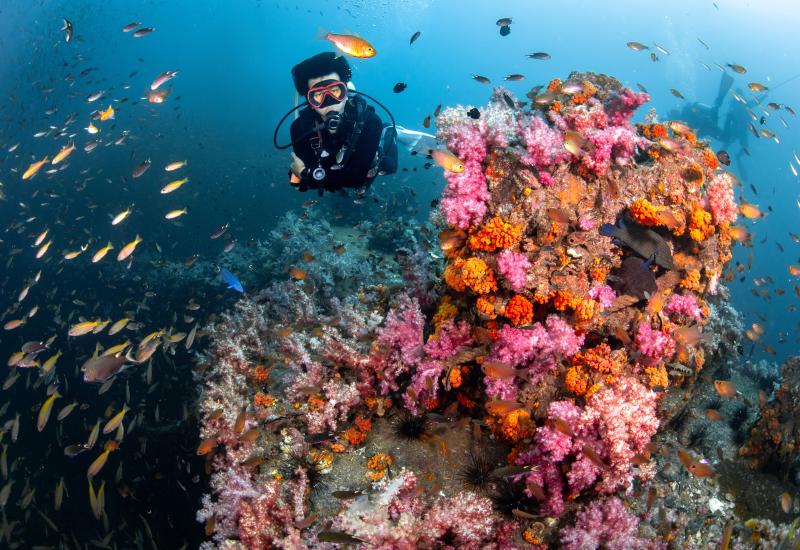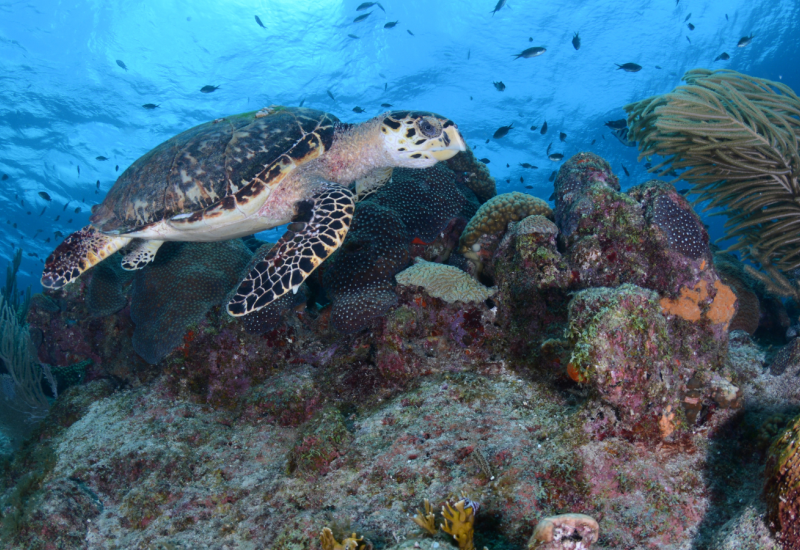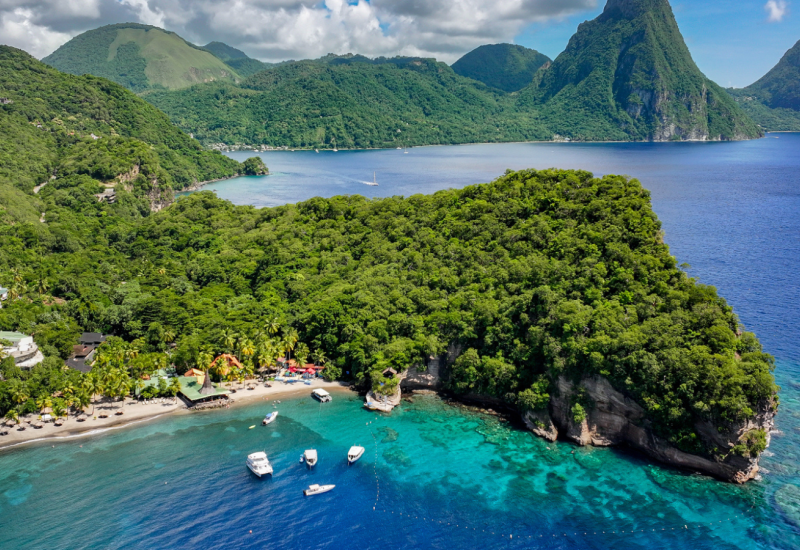What It's Like to Dive the USS Oriskany

Courtesy Mike WinklesThe USS Oriskany, located off Pensacola, Florida, is the world's largest artificial reef.
A titan lurks below, and I shiver in anticipation.
As the sun bounces cheerfully off the low Gulf swells, our charter boat eases out of Pensacola’s marina, taking us on a smooth, surreal, 25-nautical-mile glide over cobalt waters. Details of the Florida coastline shrink from towering buildings to toy blocks, then finally slips from view altogether. Now, hidden beneath the glassy surface, the USS Oriskany waits—a massive, silent monument resting at the bottom of the Emerald Coast, shrouded in history and brine.
Military Machine Turned Underwater Monument
Known affectionately as The Mighty O, the Oriskany’s story began long before she became the world’s largest artificial reef. She began cutting through the seas in 1952, sailing as part of the Pacific Fleet in the Korean War. Pilots unleashed barrages and coordinated strikes from her decks, ultimately bringing down MiG-15s and earning Oriskany two battle stars. Years later in Vietnam, she truly proved her fortitude, launching over 12,000 military operations, dropping nearly 10,000 tons of ordnance as part of Operation Rolling Thunder. Despite suffering huge losses in aircraft and men, she always came back, relentless. October 27, 1966, brought disaster: a fire that claimed 43 lives. Less than a year later, she returned to battle. Legendary aviators James Stockdale and John McCain were among her ranks, both captured during missions. Through fierce combat and heavy losses, the Oriskany exemplified steadfast courage and the indomitable spirit of her crews.
By 2006, the metallic veteran had a new and unique mission—to become a haven for divers to explore. The day the U.S. Navy sank her, a flotilla of boats surrounded the site, locals watching in excitement as she made her final descent—a quick farewell overall, as she plummeted in just over thirty minutes.
What awaits me isn’t just a relic of military steel—it’s a living marine citadel.
Related Reading: 4 Essential Tips for Booking Your Next Scuba Diving Trip
The dive briefing comes and goes, the typical medley of depth limits, current warnings and careful descent plans. The Mighty O sank lower than intended, so penetration points ended up below the 130-foot recreational limit. The bridges are open to explore, ranging from 107 to 134 feet, with the top of the stack around 84 feet. Hit the flight deck and you’re 146 deep, and the hangar bay finds divers 175 feet from the surface.
The bottom of the hull crests 212 feet, so only tech divers can penetrate her interior maze, an increasingly advanced undertaking after years have encrusted her windows so thoroughly that techies will at times use flare lights and a wreck reel in order to make their way back. Those of us with run-of-the-mill training, like me, have the opportunity to thoroughly inspect her hulking exterior.
Our divemaster, Austin, ties a descent rope securely to the wreck for our orientation. As a seasoned diver and contractor for the Navy specializing in underwater archaeology, he exudes a calm confidence, which is a reassuring presence as we prepare to meet the giant below.
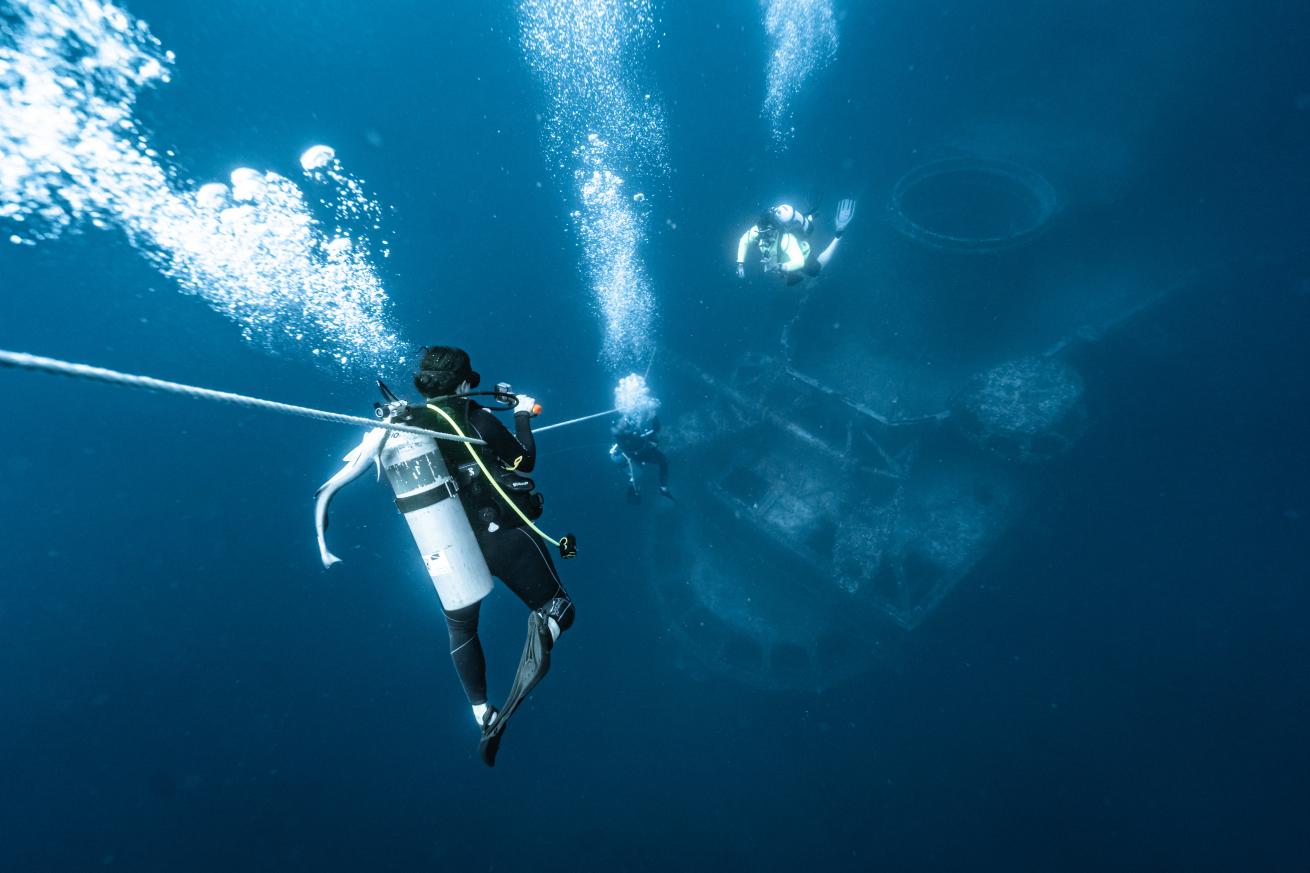
Courtesy Mike WinklesDivers descend to the Mighty O, which rests over 200 feet deep, with shallower sections accessible to those with advanced open water certification.
Exploring a Colossus
A splash starts our descent into the blue, and soon the surface world melts away. Life greets us instantly. First comes a suspension of jellyfish, an ethereal entrance that undulates gently in the current. A playful remora darts around us and I ward it off with my GoPro handle, forcing it to perch on the tank of my dive partner Elaine.
This interloper distracts me so thoroughly during the descent that I fail to notice the metal monstrosity appearing below. All of a sudden, there she is: The Mighty O’s conning tower pops through the deep haze, its island structure emerging below with the slow drama of an unwrapped gift. Soaring over the top of the wreck, I realize I have the same view of the ship as former navy pilots who once soared toward its sovereign deck—and what a view it is!
The scale itself is staggering. At nearly 890 feet, the ocean obscures the bow and stern. I am instantly grateful we have two dives planned for this trip, because it will take me the entire first dip just to process the sheer size of the reef before me.
Finning slowly above the flight deck at 80 feet, I easily imagine the roar of fighter jets that once soared above. (We also watched the Blue Angels practice in Gulf Island National Seashore just the day before, so the sound of military aviation is fresh in my mind.) Now, the stripes of the landing deck lay faded as they trail into the distance, guarded by two flags—the American and POW—gently swaying in the current like sentinels saluting the past. Brady Hale, a dive guide and board chairman of the local conservation group Ocean Strike Team, unfurls the POW flag from a tangle, sprinkling off algae like snowflakes, scattering past shoals of darting fish.
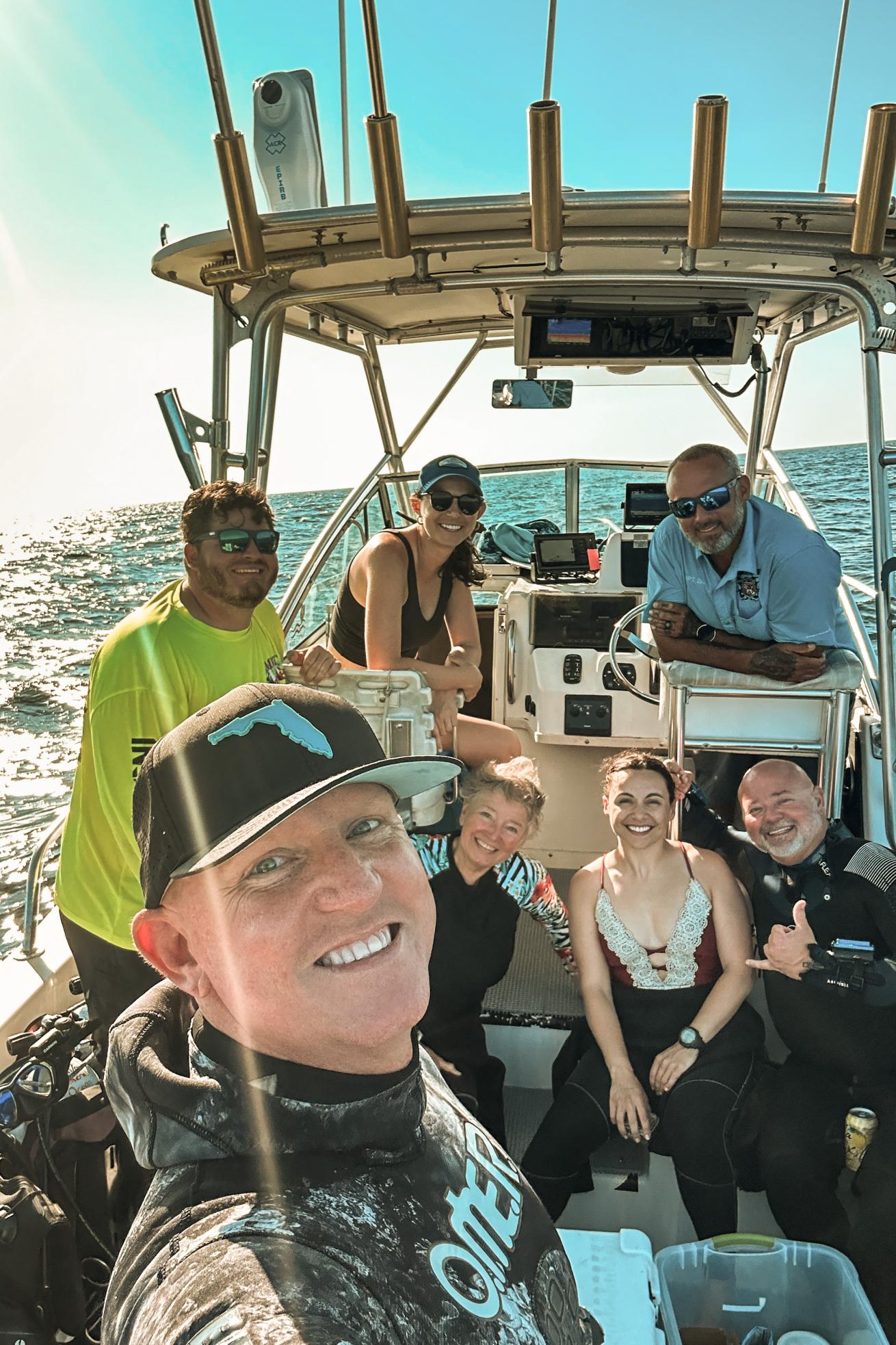
Courtesy Mike WinklesDivers are all smiles about diving the world's largest artificial reef.
I spy what looks like wiring running its way up the side of the deck. Closer inspection shows its shells embedded atop each other, cemented on with algae and neon anemones. I am struck by how much color there is here. It’s not just the typical grays, browns and beiges, but there’s green, red and creams popping out in the wreckage. This is not just a drab hunk of discarded tin, but an ever-changing tapestry. Scallops covered the Oriskany within two days of sinking, I’m told by Kerry Freeland, the owner of Dive Pros who is among those responsible for bringing the Mighty O to Pensacola. He recalls clouds of scallops dancing past him as he approached for the first time, and today, years later, life continues teaming around us. Barracudas hover like wary sentries, a cobia flashes past and swirls of smaller fish move in synchronized waves, punctuated by the sudden appearance of a resident grouper. I’m told a shy grouper, Felicia, lives at 147 feet, but this friendly fellow patrols his 90-foot-deep territory with languid authority, tracing slow circuits through what was once the ship’s operational nerve center. I follow him momentarily as he disappears through a gaping breach in the bulkhead, emerging into sunlight fractured by the ever-thinning water above.
Related Reading: Readers Choice: World's Best Places to Go Scuba Diving in 2025
The alluring, deeper sections call out to me on our second dip that afternoon. Now comfortable with the depth of each ship marker, I find myself checking my gauges less and staring in awe at the vessel more. There are endless sites to take in, and though I can’t enter this monument yet, there are swim-throughs “the size of a three-story building,” as Brady puts it.
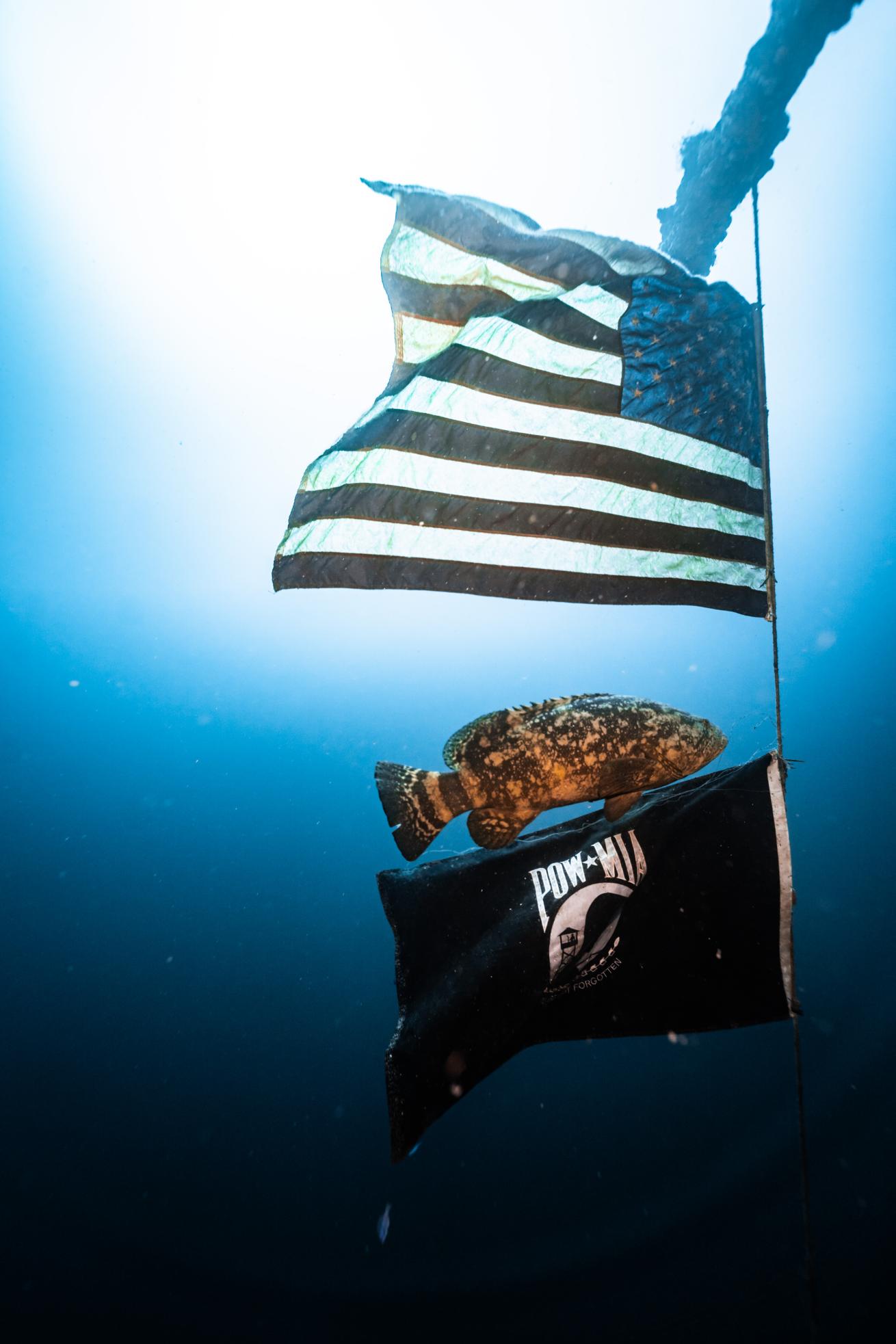
Courtesy Mike WinklesMany species like this Goliath grouper are found among the Oriskany.
We make a pass through one of the towering swim-throughs at about 100 feet—a jagged, metallic cavern. Bubbles from another diver ahead whisper against the ceiling, dislodging tiny flakes of life that shimmer as they fall, leaving me to guard my exposed neck from their sting. I marvel at how time and nature had painted over these military halls, cementing once-gleaming metal with layers of shells and vibrant algae, accented by bursts of red and green anemones. As we emerge on the other side, my grouper friend reappears above the flags, soaring regally above the patriotic stripes.
By now, I begin to enjoy the wreck’s imposing enormity and it feels like a playground rather than an overpowering monument. I frame shots with my GoPro, capturing the stern silhouette of the structure and struggling to fit even slivers of this giant into my lens.
As the dive winds down, we surface through a pelagic corridor where clouds of jellyfish drift in the current like ghostly lanterns, accompanied by a retinue of sleek barracudas. Gripping the descent line, I relish the momentary timelessness, the weightless joy buoyed by the hum of adventure.
Back aboard, our boat races toward a horizon splashed with the embers of sunset, flying fish cutting rainbows in our wake. Oriskany might have been designed to conquer the skies and defend coasts, but down below, she’s found a new life—one adorned with creatures, coral, and divers’ awe. Each visit is a reminder that even retired titans can become sanctuaries, humming with a life all their own.
Need to Know: How to Dive the USS Oriskany
Gear: 5 mm wetsuit; surface marker buoy
Water Temps: Mid-80°F in summer; mid-60°F in winter
Dive Season: Year-round
Suggested Certifications: Advanced Open Water, Deep Diver, Wreck Diver, Nitrox
Operators: Emerald Ocean Divers ($200 recreational two tanks; $225 tech two tanks); Niuhi Divers ($225, two tanks); Gear rental available from Dive Pros (standard scuba package – $44.95)

